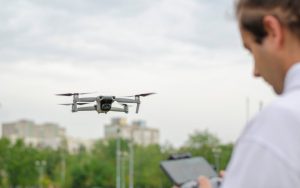Shielding the Skies, Strengthening Airspace Security: A Comprehensive Guide to Modern Airspace Defense
The New Age of Airspace: Opportunity and Danger
Over the past ten years, our interaction with the skies has been significantly redefined. Drones, which were once exclusive to military use, have transitioned into everyday tools utilized by photographers, emergency responders, enthusiasts, and even delivery services. Although the accessibility of these technologies has grown, so has the spectrum of threats they pose. “We are in an era where drones are universally accessible,” highlights Mary-Lou Smulders, the Chief Marketing Officer at Dedrone by Axon, leaders in global airspace security. “They are affordable, readily available, and extremely potent, and this evolution shifts the threat landscape—not just for the military but for urban areas, businesses, and prominent events.”
By the Numbers: The Urgency of Airspace Security
- More than 2,600 reported drone incidents near U.S. airports in 2023—a sharp increase from under 500 in 2016.
- Over 500 drone-related contraband deliveries to correctional facilities in North America during the past year.
- 13,000+ illicit drone activities recorded globally in 2024 across 40 nations.
- Unauthorized drone actions near critical sites in the UK grew by 64% between 2021 and 2023.
The evidence is compelling: airborne threats are no longer speculative—they are occurring currently and can have substantial repercussions for public and national security.
What’s at Stake? The Expanding Threat Landscape
The Promise and Peril of Drones
Drones offer unprecedented capabilities in fields such as search and rescue, infrastructure evaluation, creative endeavors, and wildfire monitoring. However, their extensive availability also allows nefarious entities—like smugglers, vandals, terrorists, and hostile agents—to exploit these tools for disruptions, sabotage, or espionage.
Real-World Incidents
- Airports: Drone incidents have led to runway closures, flight delays, and passenger safety threats.
- Prisons: Contraband deliveries via drones remain a consistent issue, with criminal groups exploiting detection loopholes.
- Critical Infrastructure: Reports of unauthorized aerial activity at power facilities, government buildings, and stadiums have increased.
- Conflict Zones: Drones are increasingly used in military contexts for surveillance and attacks, making civilian airspace a tactical focal point.
How Are We Responding? The Evolution of Airspace Security
A Multi-Layered Defense: From Policy to Technology
As threats grow, governmental and corporate measures are in motion to secure airspace. The U.S. has implemented extensive executive orders to initiate new strategies, encourage interagency cooperation, and accelerate the deployment of counter-drone technologies.
Key Initiatives and Legal Framework
- Executive Orders: U.S. leadership mandates a Federal Task Force aimed at restoring airspace sovereignty and expediting the integration of unmanned aerial systems into the National Airspace System. This includes stricter law enforcement against unlicensed drone activities and new restrictions on flights over crucial infrastructure and public spaces.
- Temporary Flight Restrictions (TFRs): The FAA is intensifying dynamic airspace controls, notably around significant events such as presidential visits and international conventions.
- Risk-Based Assessment: Important locations, including borders, major airports, federal institutions, power stations, and military bases, are being identified as special protection zones.
- Expanded Law Enforcement Authority: Authorities are empowered to detect, track, and neutralize unauthorized drones, with state and local asset improvement through advanced detection equipment funding.
The Technology Behind the Shield
Counter-UAS (C-UAS): Detect, Identify, Track, Mitigate
In a high-risk environment, novel technological approaches have been developed. Dedrone by Axon, winners of the Inside Unmanned Systems Innovation Vanguard Award, illustrate how technology aligns with strategy to enable comprehensive protection.
What Does a Modern C-UAS Solution Look Like?
- Multi-Sensor Detection: This includes radio frequency sensors, radar, optical and acoustic sensors to create a comprehensive detection system.
- AI-Powered Identification: Machine learning assists in distinguishing between authorized and unauthorized drone flights, enhancing accuracy and quickening response times.
- Automated Tracking: Visualization and prediction of paths in real-time allow operators to determine a drone’s current and projected locations.
- Active Mitigation: Where feasible and permissible, C-UAS systems may jam signals, capture, or disable rogue drones.
- Integration with Existing Security: These systems integrate seamlessly with established security protocols for a coordinated response.
Real-Life Applications
At international airports, these layered systems have mitigated numerous incidents. Correctional facilities rely on Dedrone’s technologies to prevent contraband deliveries, thus conserving resources and ensuring safety. During the 2024 Summer Olympics, an integrated setup of AI tracking and ground teams ensured the continuation of activities despite intrusions.
Key Trends Shaping the Future of Airspace Security
From Drone Swarms to AI Arms Race
According to Dedrone’s 2025 Airspace Security Report, future challenges and trends include:
- Drone Swarm Proliferation: Adversaries may use coordinated drone groups to test defenses.
- AI-Driven Offense and Defense: Both attackers and protectors turn to AI for countermeasures, signal interference, and adaptive flight dynamics.
- Increased Commercialization: The rise of drones in delivery, surveillance, and safety roles presents both new opportunities and risks.
- Global Regulatory Push: Nations are adopting standard regulations for drone registration, licensing, and monitoring.
Security in Practice: Major Events, Critical Infrastructure, and Everyday Operations
Securing Major Events
Large gatherings such as sports events, concerts, and political rallies pose unique challenges. Preparations for the 2026 FIFA World Cup and 2028 Summer Olympics include the establishment of National Counter-UAS Training Centers and collaboration with Joint Terrorism Task Forces.
Protecting Critical Infrastructure
Operators of essential utilities and communication sites are receiving guidance and resources, from best practices to modular detection systems, to secure their facilities. Federal incentives back private adoption of C-UAS technologies.
Everyday Airspace
Enhanced geofencing, continual airspace surveillance, and public education ensure that personal drones, while increasingly common, remain controlled. The FAA supports NOTAM updates and airspace restrictions with automated navigation systems.
Challenges and Controversies
Balancing Security and Innovation
Decision-makers face a dual responsibility: nurturing drone industry growth while preventing misuse. Excess regulation may inhibit innovation, while laxity threatens public safety.
Privacy and Civil Liberties
Critics are concerned that extensive drone detection and AI surveillance could infringe on privacy rights and lawful personal activities. Clear legal specificity and operational transparency are paramount.
Global Hotspots
In zones of unrest, like the Kashmir region, airspace security holds life-and-death implications. To counteract repeated cross-border drone incursions, many countries advise avoiding specific flight zones, with some even shutting down airspace amid conflict.
The Human Element: Collaboration, Training, and Community Engagement
It Takes a Village (and a Lot of Training)
Effective defense of airspace relies on teamwork. National organizations, local agencies, corporate entities, and community leaders must collaborate, develop methods, and engage in ongoing training.
- National Training Centers for Counter-UAS are crucial for preparing operators to contend with changing threats.
- Community Outreach Programs are instrumental in informing enthusiasts and commercial pilots about new rules and suspicious activity reporting protocols.
Success Stories and Everyday Heroes
Successfully thwarting drone threats involves dedicated professionals—technicians, security personnel, trainers—who apply their skills to maintain air safety. Organizations like Dedrone provide more than technology. They offer comprehensive support, training simulations, and quick incident response.
At times, even a keen hobbyist plays a pivotal role by detecting and reporting rogue drones, reminding us that everyone is integral to airspace safety.
Looking Ahead: Expert Tips for Navigating the Future of Airspace Security
- Stay Informed: Threats and regulations evolve. Stay current with NOTAMs, FAA advisories, and local restrictions.
- Invest in Layered Solutions: A combination of detection, tracking, and mitigation technologies is necessary for defense.
- Build Relationships: Engage with local authorities, industry networks, and peers for intelligence and best practices exchange.
- Prioritize Training: Regular drills ensure that technological tools are effectively utilized.
- Advocate for Smart Policy: Support regulations that equitably balance innovation and security, and endorse transparency in implementing counter-UAS actions.
A Closing Thought: Shielding the Skies Is Everyone’s Mission
The skies, once vast and empty, are now a dynamic and critical sphere. Protecting this space requires more than technology; it needs a concerted effort involving foresight, vigilance, and collective spirit. As drones become ubiquitous, our true defense lies not just in our technological prowess but in our community cooperation, regulatory clarity, and committed vigilance.
The era of airspace control is here. Collectively, we can safeguard the skies and ensure a secure and intelligent future for all.













